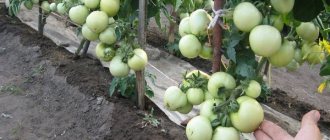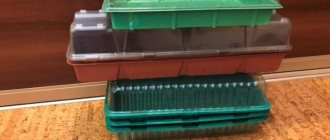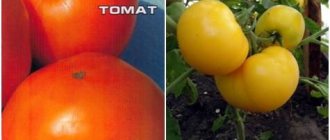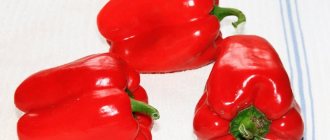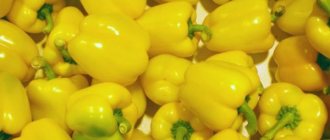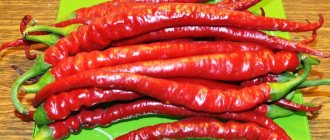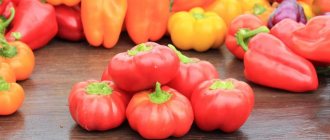Sweet pepper Red Riding Hood is a breeding development of the Aelita agricultural company. Solanaceous crop is loved by gardeners for its early ripening, abundant yield and beautiful fruits with an excellent peppery taste. In the middle zone and southern regions, the variety is cultivated in unprotected beds and under film covers. In areas with cold and short summers, it is recommended to grow peppers in greenhouses.
Description and characteristics of the variety
Red Riding Hood is a mid-early cultivar. The period from mass germination to the formation of fruits at technical ripeness is 110-120 days. Ripening times largely depend on growing conditions and weather conditions.
In the description of the variety, the originator indicates that Red Riding Hood is unpretentious to light and calmly tolerates night and day temperature changes after planting in a permanent place.
The plant forms a medium-sized bush, not exceeding a height of 0.7-0.8 m in a greenhouse. In open ground, the central stem may finish growing a little earlier, without reaching these marks.
The variety is classified as semi-standard. This means that the plant has a fairly powerful main stem, good foliage and a compact crown. A large number of leaves darken the fruits, saving them from sunburn in hot weather.
Each plant produces 6 to 8 fruits at a time. During the season, an average of 12 peppers are harvested from one bush, which is a total weight of 2.5 kg of the crop.
The red cap forms fruits in the form of a cube up to 10 cm long. The flesh of the peppers is fleshy, the thickness of the pericarp walls is 8 mm (see photo).
The weight of one vegetable at technical ripeness is on average 200 grams. When they reach biological maturity, peppers can be poured up to 250 grams directly on the bush.
When set, the vegetables are a rich dark green color, which changes to bright red when fully ripe.
Juicy and tasty fruits with a pronounced peppery taste can be consumed at technical ripeness. But they reveal their full flavor potential only after they turn red.
It is recommended to remove peppers from the bushes at the stage of technical ripeness so that they do not draw nutrients onto themselves from the formed ovaries. The fruits ripen well at home.
Vegetables are good for fresh consumption and are also suitable for various types of culinary processing.
Landing
The sowing period lasts from mid-February to the end of March. Before planting, it is advisable to treat the seeds:
- Soak in heated water.
- Disinfect (Fitosporin, manganese solution).
- Stimulate (folk remedies - aloe, honey, as well as humate or Immunocytophyte).
To grow strong seedlings, you need nutritious soil with compost and phosphorus-potassium supplements. A special microclimate is created for the bushes with a temperature of 20-26 degrees, humidity at 60-70%.
Features of cultivation and care
The timing of planting seeds for seedlings of the Red Riding Hood variety is the last week of February - the first ten days of March. In the southern regions and when cultivated in greenhouses, sowing is carried out earlier.
The gardener should be guided by the fact that seedlings appear on average after 7-10 days (sometimes later), and seedlings are transplanted to a permanent place at the age of 60-70 days. By this time, the risk of return frosts should have passed, and the first buds should appear on the plants. Those. sowing is carried out approximately 80 days before transplanting into the ground.
The originator recommends placing it on sq. m. 3-4 plants. However, many gardeners practice the thickened planting method, planting up to 10 bushes in such an area.
In a greenhouse, to increase productivity, the cultivar is formed into two stems, and a trellis is used as a support.
Some vegetable growers grow Little Red Riding Hood without staking and shaping. However, without support, the stems can lie on the ground, and the formed fruits can rot.
To improve air circulation between the bushes and simplify watering, remove shoots and yellowed leaves before the first fork.
Pepper grows well and forms a rich harvest on loamy soils. In addition to high-quality soil, the crop needs watering every 3-4 days. For humidification, use only settled, non-cold water. It is recommended to carry out the procedure in the evening. Water the plants strictly at the roots, without getting on the foliage. Caring for the crop also includes loosening the soil and weeding.
Little Red Riding Hood is very responsive to feeding. The manufacturer recommends using the Aelita-vegetable mineral complex as a fertilizer.
With proper agricultural practices and a warm climate, the first harvest is harvested in July. Plants bear fruit until the end of September.
Planting and growing
In February, work begins on sowing pepper seeds for seedlings. At the end of May or at the beginning of June, it is time to plant seedlings in open ground. The age of the plants by this time is 90 or 100 days. Young bushes have at least 10 leaves, and growth reaches 25 cm.
In garden plots in Siberia, the heat-loving crop is planted under temporary shelters or in greenhouses. Early planting times require additional efforts from vegetable growers:
- hardening of seedlings;
- treating plants with growth stimulants;
- the use of foliar fertilizers when weather conditions worsen.
Younger pepper seedlings can be planted in greenhouses (50–60 days). Before planting, the soil is filled with organic (compost, humus, peat, ash) and mineral (superphosphate, potassium sulfate, urea) fertilizers.
The standard planting scheme for thick-walled pepper varieties is 4 bushes per 1 m². Low-growing hybrids (varieties) can be planted more densely. It is necessary to read the instructions, which provide specific information on the correct planting of a certain type of pepper.
Diseases and pests
According to reviews from vegetable growers, the Red Cap sweet pepper is resistant to the main nightshade diseases. Despite this, you should still follow agrotechnical rules that will help avoid problems with plant health. Disease prevention comes down to the following measures:
- compliance with crop rotation;
- removal of yellowed foliage;
- treatment with biofungicides;
- regular inspection of bushes.
To prevent peppers from being favored by harmful insects, repellent plants (tansy, calendula, etc.) are planted nearby.
Tomato Red Riding Hood characteristics and description of the variety. When to plant
Tomato lovers appreciate them for their delicate sweet taste, juicy pulp and attractive appearance, which decorates many dishes. They are revered in fresh and cooked forms, as well as in various preserves. The delicious Red Riding Hood tomato stands out with its pleasant taste and bright, beautiful appearance.
Characteristics of the tomato variety Red Riding Hood
Characteristics and description of the Red Riding Hood variety demonstrates that these are early-ripening tomatoes, low-growing, and do not require pruning of excess shoots and tying.
They grow mainly in the form of a trunk (tree) and have a strong rhizome. Thanks to this, their cultivation is acceptable in greenhouses and even on a windowsill. In addition, seedlings are not picky about temperature changes and can easily tolerate cold spells of several days . The height of the plant reaches an average of 40 cm, but not higher than 70 cm.
What are the fruits?
- round, slightly flattened at the poles;
- rich red color;
- weight about 60 g;
- the skin is tender;
- the number of seeds in a tomato is insignificant;
- the taste is sweet, slightly sour.
Tomato, variety Red Riding Hood, ripens 95-100 days after planting in the ground. Its productivity is high - up to 2 kg per bush. There are about three to five fruits on a branch. Among the beneficial substances, tomato contains amino acids, lycopene, and sugar.
The variety of early ripening tomatoes, Red Riding Hood, was bred by German breeders for cultivation in open ground, as well as in greenhouses and on a windowsill at home.
Red Riding Hood tomatoes can be picked green and allowed to ripen indoors.
Specifics of growing the variety
As the description shows, the Red Riding Hood tomato is grown from seedlings. Seedlings should be planted in early spring (March - first half of April). It is best to plant seeds that have been sitting for 2-3 years. They are first soaked in a growth stimulant - this can be aloe juice - and disinfected with a weak solution of potassium permanganate. Then they are rinsed and dried.
For planting seeds, fresh soil that is not oversaturated with fertilizers is suitable. For better germination, you can add wood ash, clean river sand, and superphosphates. It is better to sow in special containers with separate holes. This will avoid diving. The seeds are placed in the ground to a depth of about 1 cm. The optimal temperature for seedlings is 23-25ºC. Watering should be regular, but moderate, using settled water at room temperature.
The seedlings are moved into open ground 60-70 days after sowing. This is usually the end of May - beginning of June. A week before planting, the seedlings are hardened off in the fresh air.
The predecessors in the selected bed should be beans, peas, carrots, cabbage, lettuce or herbs. It is strictly not recommended to plant tomatoes where potatoes, eggplants and sweet peppers are harvested. Growing Red Riding Hood tomatoes is done on well-loose soil fertilized with humus. Watering is required as the soil dries with plenty of water. The bushes should not be too close to each other - no more than 3-4 plants per square meter. On the windowsill they should be placed in flowerpots with a volume of 3 liters.
With the right approach to agricultural technology in Red Riding Hood tomato beds, you are guaranteed to get:
- large quality harvest;
- tasty and appetizing fruits;
- rapid rise and ripening without much effort;
- healthy and tasty food all year round.
Advantages and disadvantages
Based on the reviews of summer residents and the characteristics of the originator, the following advantages of the Red Riding Hood sweet pepper should be highlighted:
- tasty, large and beautiful fruits of universal use;
- high yields in any growing conditions;
- resistance to short-term cold snaps;
- good tolerance to lighting deficiency;
- universal use in cooking.
Among the disadvantages is the need to fix the central stems to supports, which can fall to the ground due to the heaviness of their fruits.
Rules of care
During the growing season, pepper Red cheeks:
When growing peppers in a greenhouse, it is regularly ventilated. Experienced gardeners recommend forming bushes. Either in the form of a trunk, removing all the lower shoots, or growing a crop of 2-3 stems. Otherwise, there is a possibility of thickening of plantings and overloading of plants with fruits.
Similar varieties
According to the characteristics and description of the variety, Red Riding Hood is similar to the following varieties of pepper:
- Big Boy;
- Red side;
- Quadro ed;
- California miracle;
- Fatty.
The Big Boy variety belongs to the Aelita agricultural company. The crop yields milky ripeness after 110 days. It can form fairly tall bushes in a greenhouse (up to 1 m), in open ground it rarely exceeds 0.5 m. The shape of the fruit is cubic, weight is up to 200 g.
The red side begins to bear fruit on average after 105 days. Red cube-shaped fruits are poured up to 250 g. subject to complete ripening in the vegetative system of the plant. The cultivar is not afraid of the main nightshade diseases.
Quadro red belongs to the mid-early varieties of Siberian selection. This means that pepper is resistant to unfavorable climatic conditions. The cube-shaped fruits are in many ways similar to Little Red Riding Hood: they are large (up to 300 grams), thick-walled (7-8 mm), and bright red when fully ripe. One plant brings up to 2.5 kg of harvest.
On average, the California miracle pepper begins to bear fruit 130 days after sowing the seeds for seedlings. The variety is adapted to any weather conditions. The powerful central stem, 80 cm high, has good foliage. Cube peppers weighing up to 160 g. form a pericarp wall up to 9 mm. The cultivar is resistant to verticellosis. Productivity per sq. m. under film covers is 8-10 kg.
The mid-early cultivar Tolstyachok forms a harvest after the beginning of the growing season after 120-130 days. The semi-spreading plant, no more than 55 cm high, bears up to 12 fruits. Cuboidal red peppers are distinguished by their large fruit (up to 250 grams) and thickness (up to 1 cm). Unlike Little Red Riding Hood, the bush does not need shaping or staking.
Variety or hybrid: which is better?
First, let's figure out what the differences are between a variety and a hybrid. So, a variety is the result of selection, and a hybrid is the result of crossing. The first ones are selected and adapted to certain climatic conditions of the area. Seeds from grown peppers can be used for germination and planting. As a result, plants grow with the same external and taste parameters.
Hybrids are distinguished by larger fruit sizes, improved taste and higher yields. The bushes are compact and easier to care for. Hybrids are resistant to various pests and diseases. Special agricultural technology is used to grow them. Fruit seeds are not suitable for cultivation. Since the plants obtained from them do not have similar genetics. Hybrids are marked on the packaging as follows: F1. For example, pepper Denis F1, Iceberg F1. The cost of seeds of such varieties is an order of magnitude higher than that of conventional varieties.
The best varieties of sweet peppers for open ground
Many summer residents grow sweet peppers on their plots, the varieties of which are now so diverse that they allow you to get excellent harvests in any conditions. Bell peppers are very healthy because they contain a large amount of vitamin C, carotene and vitamin PP. In addition, peppers are rich in micro and macroelements and other vitamins. Bell peppers can be grown both in greenhouses and in open ground, the main thing is to choose the right varieties. We offer you a detailed overview of the best varieties of sweet peppers for open ground.
What you should consider when choosing pepper seeds for seedlings. What varieties of bell peppers are recommended to be grown in the central region.
Despite the huge selection of sweet pepper seeds in stores, you should carefully select the variety for your plot. Let's first figure out which pepper you like in terms of shape, color and wall thickness.
The best varieties of sweet peppers for open ground
Among the varieties of peppers for open ground, the best, in my opinion, are the early, large-sized peppers with thick, fleshy walls. Among such varieties, zoned for our region, we can highlight: EARLY VARIETIES:
- Pepper Alexy is light red, with very large cone-shaped fruits of good taste;
- Pepper Baloven is a tall plant with large prism-shaped red fruits, the thickness of the fruit walls is up to 10 mm, the taste is excellent;
- Big Girl pepper - large orange fruits with thick walls, good taste;
- Big Gold pepper is a medium-height plant with large orange fruits of good taste;
- Pepper Wunderkind is a plant of medium height with very large orange-colored fruits, the thickness of the fruit walls is average, the taste is excellent;
- Dunyasha pepper is a medium-sized plant with large thick-walled yellow fruits, excellent taste;
- Yenisei pepper is a mid-season plant with large cube-shaped fruits of orange color, the walls of the fruit are thick, the taste is excellent;
- Red elephant pepper - red, very large pepper with thick fleshy walls, universal use;
- Pepper Carlson is a low plant with large cube-shaped red fruits of excellent taste;
- Zabava pepper is a large red pepper, cone-shaped, with thick walls;
- Pepper Player - tall, low-growing, with large cube-shaped fleshy fruits of good taste, high yield;
- Boar pepper is a tall plant with large conical fruits, very thick-walled fruits with excellent taste.
- Red Cap pepper is a plant of medium height with large cube-shaped fruits of dark red color, the wall thickness is average, the taste of the fruit is excellent;
- Capsicum pepper is a tall plant, the fruit is large, cylindrical, dark red, with medium-thick walls.
- Chernobrovka pepper is a plant of medium height with very large cylindrical fruits of dark brown color; large wall thickness, excellent taste and high yield are the main differences of this variety.
MIDDLE VARIETIES:
Alyosha Popovich is a standard plant, the fruits are prism-shaped red, with walls of medium thickness, good taste.
- Aphrodite is a tall plant with large yellow prism-shaped fruits, thick-walled fruits of excellent taste;
- Blondin is a tall plant with cylindrical yellow fruits weighing 250-300g, excellent taste and yield;
- Gromada is a tall plant with large cube-shaped fruits of dark red color, the walls of the fruit are thick, the yield and taste are excellent;
- Pearl of Siberia is a plant of medium height with cube-shaped red thick-walled fruits of good taste;
- Golden Barrel is a medium-height plant with large yellow cube-shaped fruits, excellent taste.
- Ilya Muromets is a standard plant with large red fruits, excellent taste, does not require shaping;
- Red cheeks are a plant of medium height, very large cylindrical red fruits, wall thickness 7 mm, excellent taste.
- Titan is a plant of medium height with large prism-shaped red fruits, wall thickness 7 mm, excellent taste.
LATE VARIETIES:
- Chinese lantern pepper is a low-growing plant with a cylindrical red fruit, large, thick-walled fruits of excellent taste, the plant is characterized by good fruit set under temperature changes.
- Trapez is a medium-sized plant with large cylindrical red fruits, wall thickness 9 mm, good taste.
We hope our recommendations will help you choose the best varieties of peppers and grow a huge harvest!
Adding a new comment
smoldacha.ru
Characteristics
- The variety is early ripening. The period from the emergence of seedlings to the beginning of ripening is only 85 - 90 days;
- Harvest begins on July 10 and lasts until early September;
- marketable yield, according to the State Register, is 1.8 kg per 1 square meter. According to the originator, this figure is 2.0 - 3.0 kg per 1 sq. meters;
- The baby tomato has excellent immunity. High resistance to fusarium wilt, verticillium and tobacco mosaic virus is noted;
- the fruits do not crack;
- according to reviews from gardeners, the germination rate of the seed is high;
- Despite their almost toy size, tomatoes can be used not only in their natural form, they are excellent for whole-fruit canning;
- You can collect Little Red Riding Hood seeds yourself for further cultivation.
Plant care
How to care for Red Riding Hood tomato seedlings? The characteristics of the variety indicate its resistance to infections. Even a disease such as late blight rarely affects this tomato. When growing it on a windowsill, you don’t have to worry about pests and diseases, unless there are infected plants nearby. However, when the bushes have already been planted in separate pots, it would be useful to water them with a weak solution of manganese so that the soil does not sour and whiteflies do not appear. This should be done once every two weeks.
In greenhouses and open ground, it is better to carry out preventive manipulations.
To avoid fungal infection, greenhouses must be regularly ventilated, monitor the appearance of weeds and remove them in a timely manner, and cover the soil with peat or humus. Mulching the soil will also help open soil.
Greenhouse shelters can often be infested by small insects. Industrial insecticides will help against pests such as aphids, thrips, spider mites or whiteflies.
If fruit set has already occurred, only herbal remedies can be used to combat parasites. These are decoctions of celandine, chamomile, yarrow or onion peel.
Slugs are removed with a solution of ammonia, aphids with a soap solution.
You should know that when grown on a windowsill, tomatoes are affected by the sun's rays. Even in winter, they can harm the leaves of the plant.
Sweet Red Riding Hood pepper
Regional Center Gardener Pyatigorsk with the greatest pleasure is pleased to offer you its services as a reliable supplier of gardening products. We have been working in the market of Caucasian Mineral Waters and the North Caucasus for more than 10 years, and during this period our partnerships have only become stronger and more fruitful. We are always happy to meet the wishes of the client and have prepared a range of products taking into account your needs. A flexible system of discounts has been developed for regular customers. We are representatives of products from such manufacturers as August, Technoexport, Bui fertilizers, Pokon, Aelita seeds, SeDeK, Gavrish, Russian Ogorod, Manul, Prestige, Search, lawn grasses Green Carpet, Trifolium, soils and peat Rostorfinvest, Pelgorskoye, Dubrava, Fart, Ambulance, Narodny Grunt, NovAgro and many others. We will be happy to advise you on questions of seeding and the functionality of chemicals. We provide special conditions for regions. We deliver by mail or transport company to any city in Russia. Since 2016, our website has been operating an online store of seeds and other garden products.
sadovodkmv.ru


